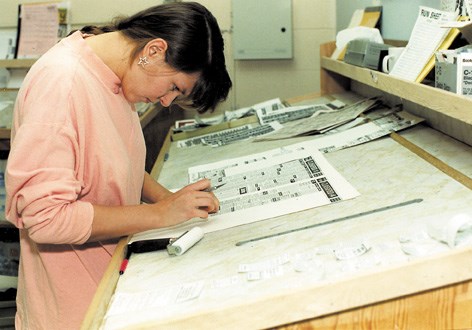Sandy Jamison still remembers her first colour scanner.
It was the size of a room, cost thousands of dollars and took an hour to produce one picture — if it worked. Operating it required a three-week course.
"It was dozens and dozens of knobs to adjust," says Sandy, who is now the production manager for the Gazette.
"Now we can get better quality from something that [costs] a couple a hundred bucks," she says.
Newspapers have gone through a technological revolution in the last 50 years, and staff members at the Gazette are still riding the crest of it.
"We've all had to relearn our jobs several times," Sandy says.
In the beginning
Like most community newspapers, the Gazette was originally printed off-site at a print shop. Presses were complex and expensive, so few papers could afford their own, says president and CEO Duff Jamison.
In the real early days, all type had to be set by hand, with setters grabbing metal letters out of boxes and arranging them in racks to be stamped on the page.
"It was quite a laborious process," he says, and it wasn't easy on editors — they had to read type that was upside-down and backwards. Linotype machines sped up the process by casting whole sentences out of hot lead.
The Gazette was first produced on an offset printer — a table-sized device that used rollers to press ink onto paper.
"It was like a little sewing machine running in the back," Duff says, and made a quiet "k-chink!" noise with every page. Each page had to be printed one at a time and hand-folded. In 1966, the paper switched to a faster press that was fed by a roll of paper.
Photos were all black and white back then, says Al Popil, who started as a photographer with the Gazette in the 1970s, and shot with manual-focus cameras on film. That film had to be developed in a darkroom, which, in the case of the paper's original office on Perron Street, was a closet. Photographers had to spend hours breathing in acidic fumes as they waggled acetate strips through chemical baths, often lit a hellish red by the safe light.
It took at least half an hour to print one picture, Popil says — longer if you had to fix the exposure. "Film has to be processed a certain way," he says, and you couldn't speed the process up for a deadline.
The stories that went with those pictures were all typewritten, Duff says, and then retyped to format them into columns. Workers then cut and paste the articles onto a layout. "In the early days it was glue," he says, so if you made a mistake, you had a problem."
This was a huge operation, Sandy says, one that often involved 25 people.
"The place was just a mess of paper," with boxes, words and (occasionally) blood from sliced fingers all over the tables. Workers often started laying out the paper at 7 a.m. and finished at two the next morning.
"You got to know people really well," Sandy says.
In colour!
Colour added a whole new host of headaches.
"When we bought our first press in the 1980s, colour was just kind of coming into the business," Duff recalls.
The Edmonton Journal had launched its new colour edition and the Gazette was using it on special occasions.
Colour film was far more complex than black and white, Popil recalls. You had to process it in complete darkness, dry the strips with a hair dryer and keep the chemical baths at a constant 38 C.
"It got really hot in there," Popil says.
The Gazette later bought a $15,000 developer machine that did all the work in 90 seconds.
Those colour photos had to be run through the aforementioned scanner before they could be printed, Sandy notes.
"It was an analog machine," she says, and needed its own climate-controlled room. The operator would use the laser-powered device to print four versions of the photo onto Mylar sheets — one for each colour used by the printer. Those sheets would be layered to reproduce the picture. If the colours weren't right, you had to tweak the settings from memory and scan it again.
"That was just hell on earth, that thing," Sandy says.
The Gazette was still using the machine as late as the 1990s.
New school is old school
Computers have made newsmaking much easier. Digital cameras let you check your shots immediately, Popil notes (instead of hours later in the darkroom), and eliminate the need to carry rolls of film.
While digital cameras now allow him to take more shots than he used to, they haven't opened the doors to new realms of creativity.
"There's nothing I couldn't do 20 years ago that I can do today [because of digital]," he says.
Photo processing now takes minutes instead of hours and is as simple as hooking the camera to the computer.
"If this had been around when I was starting, I'd have been in my glory," Popil says.
When it comes to producing a newspaper, staff can now design or change a page in minutes instead of hours, Sandy says, and can do it with seven people instead of 25.
"It's so much more streamlined and accurate," she says.
Digitization has also cut down on waste, as reams of paper and feet of film have given way to PDFs and JPEGs.
"The entire newspaper is bits and bytes now," Duff says. "We've moved away from film entirely."
But a lot of the basics have stayed the same. The press that prints the Gazette today is functionally the same as the one used in 1966, Duff says, except it's bigger and faster.
"It's still very manual," he says, and still has tonnes of knobs and levers to fiddle with.
Sandy says she doesn't miss the old days one bit.
"None of us would go back."




